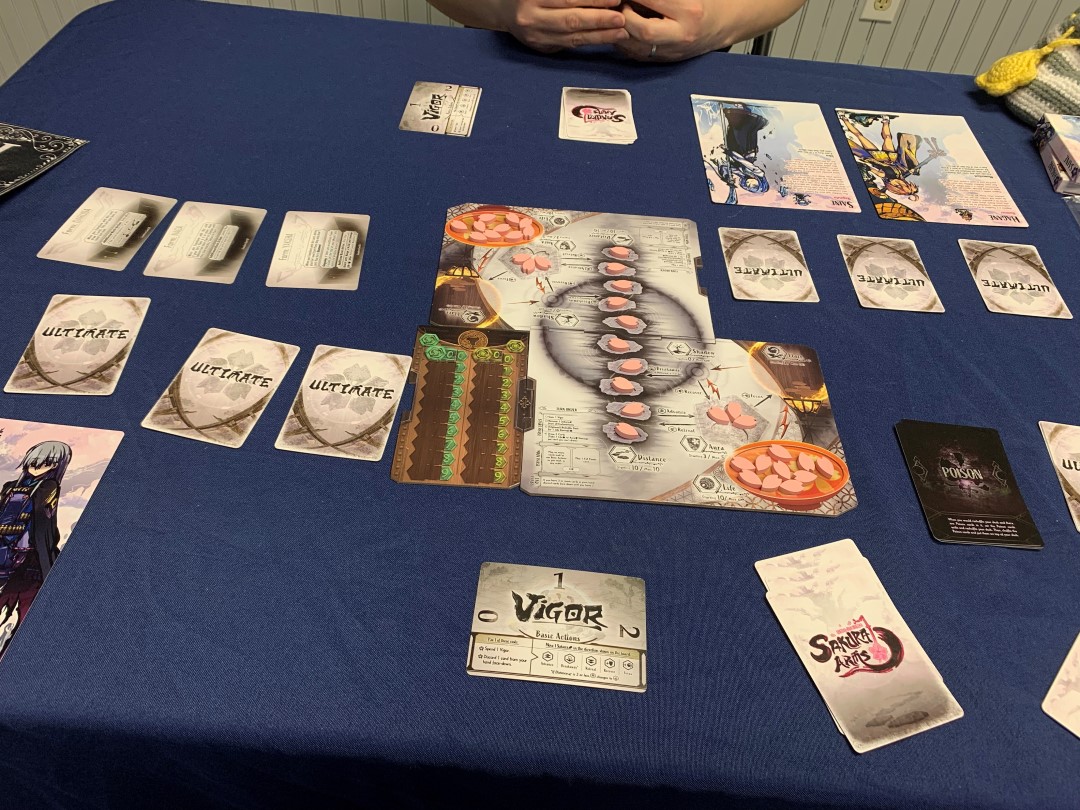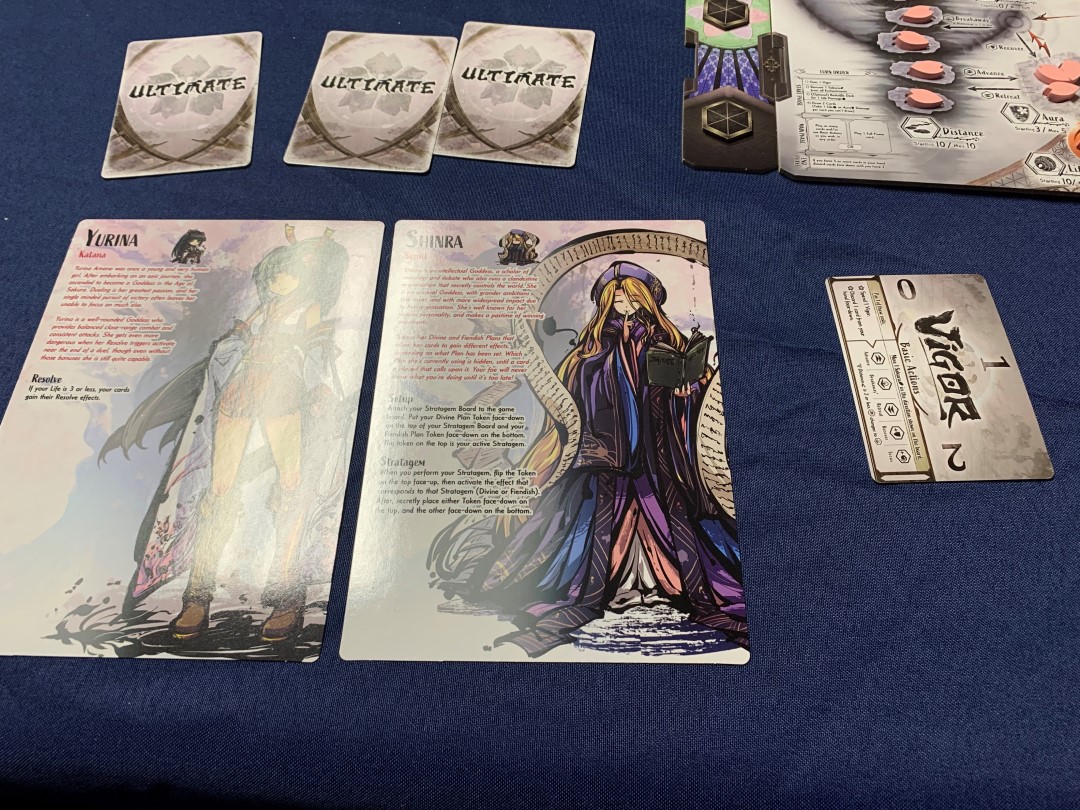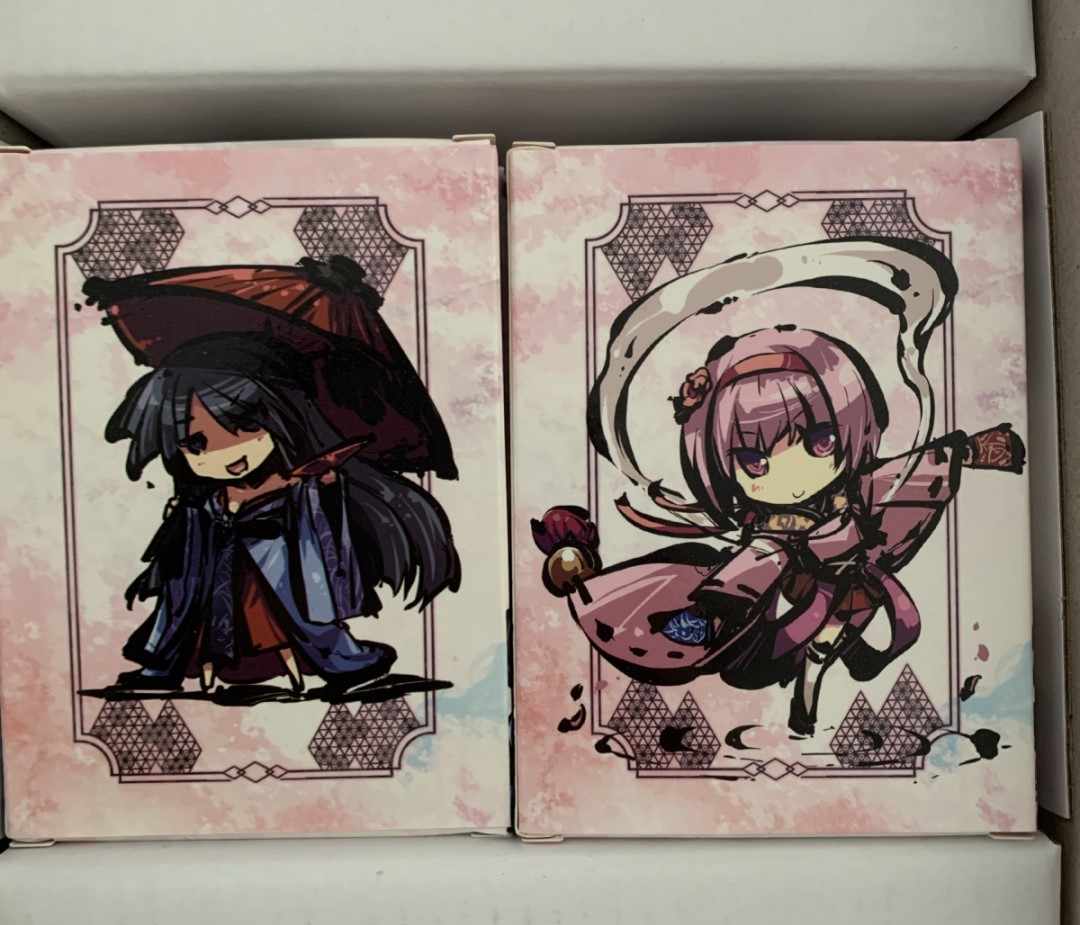Sakura Arms is one of the most popular fighting card games in Japan. The core idea is that, rather than picking up booster packs or premade decks, each box of the game contains everything you need to play. Furthermore, it is highly replayable thanks to the variety of playstyles it allows. Now, thanks to a successful Kickstarter campaign, Bakafire Party and Level 99 Games have given this unique take on a card game a full English localization and overseas release. It is also one of the most pleasant surprises I have had at a gaming table this year.

How To Play Sakura Arms?
Sakura Arms is a competitive card fighting game. Every match is framed as a sword duel with you and your opponent seeking blessings and guidance from sacred goddesses as you fight under a sacred sakura blossom tree.
Each box of Sakura Arms contains the following. You have six different Goddess boards, 40 wooden sakura petal game pieces, a game board, six different component sheets, a rulebook, and 80 different cards. At the start of every match, you pick two different Goddesses, using their boards and component sheets to better understand their unique playstyles. You then take the cards related to your selected Goddesses and assemble a small deck of ten cards. Seven of these cards are shuffled together to form your deck, the other 3 are Ultimate abilities which are set to the side and kept face-down until you activate them.
Once you and your opponent's decks are built, you put together the game board and fill it with the wooden sakura petals. If your selected Goddesses have boards tied to their unique mechanics, you attach them to the board as well. The petals represent not just the distance between your opponent, but your resources and your health as well. You and your opponent then draw and play cards in alternating turns, resolving their effects and moving petals on the board accordingly. Whoever loses all ten of their health petals loses the match.
How Does It Feel To Play Sakura Arms?
Sakura Arms made an amazing first impression with its production quality. The cards feature beautiful woodblock-style artwork, packing each of the Goddesses with personality and visual flair. The game board and sakura petals are drenched in palpable texture and care, making you feel like you are about to take part in a sacred duel between two respected equals. The wooden sakura petals are painted perfectly and sport a fine texture, making it easy to pick them up and move them consistently. The game boards are of a high quality double-layered cardboard. Each box even contains six tuckboxes featuring chibi-artwork of the various Goddesses. Finally, the English localization, barring one or two typos, is great. Whenever you pick up a Sakura Arms box, you aren't just picking up decks of cards; you are getting a full card game experience.
In addition, while each Sakura Arms box can be played as a complete standalone experience, they are also compatible with other boxes. If a single box with six Goddessses allowing for multiple different configurations and deck strategies weren't enough, try mixing and matching with all three boxes with a grand total of eighteen Goddesses.
As for playing a match of Sakura Arms, it can be intimidating at first. As mentioned before, each Goddess coincides with a certain playstyle. Yurina's a straightforward aggressive type with her katana; just close the distance and unleash hell. Shinra is all about interrupting your opponent, either by disabling abilities or by exiling cards from their discard pile. Himika uses guns, which means you have to keep your distance to use her abilities effectively. Chikage fills the opponent's deck with hand cluttering poisons that damage over time. The list goes on.

Furthermore, each Goddess' deck is made up entirely of cards that either support this playstyle or play into their more involved unique mechanics. Each one of these cards are effective and appealing in one way or another with very little unoptimal choices. If you can imagine doing a draft in Magic: The Gathering but only getting high-tier mythic rares, you have an idea of what you're in for.
However, this does make the barrier to entry higher than normal. My first matches were nightmares. Certain Goddess strategies didn't complement each other as much as I thought, or I misunderstood a mechanic and realized the playstyles weren't compatible. Or worse, my opponent caught on faster and got first pick of their Goddesses, leaving me to improvise on the fly. Even choices made in the moment are daunting. Your hand can never exceed two cards and whenever you discard at the end of a turn you discard your spares face-down to keep your opponent guessing. Sakura Arms expects you to have some experience with deck strategies as well as mind games in order to play at the level it demands and it can be a lot to process at first.
However, after my seventh match or so, everything began to click. The resource economy of the sakura petals that take into account not just your health pool and distance but your consumable defensive Aura and offensive Flair. Card combos that lead to devastating Ultimate abilities bringing my opponent to zero in a single turn. The shear variety of playstyles went from being an overwhelming demand to an exciting challenge.

Should I Buy Sakura Arms?
If you are familiar with fighting card games and are quick to learn some new strategies, I highly recommend any of the Sakura Arms boxes. If you are worried about steep learning curves and are turned off by the lack of onboarding but are still interested, I still recommend Sakura Arms. Start with the Yurina Box, and once you feel comfortable and want more, you can check out either the Saine or Yatsuha Boxes. It can be a lot to take in at first, but it is a Japanese board game experience that you won't forget.
The Sakura Arms Yurina Box, Saine Box, and Yatsuha Box used for this review were provided by the publisher.
Review Summary
Have a tip, or want to point out something we missed? Leave a Comment or e-mail us at tips@techraptor.net













